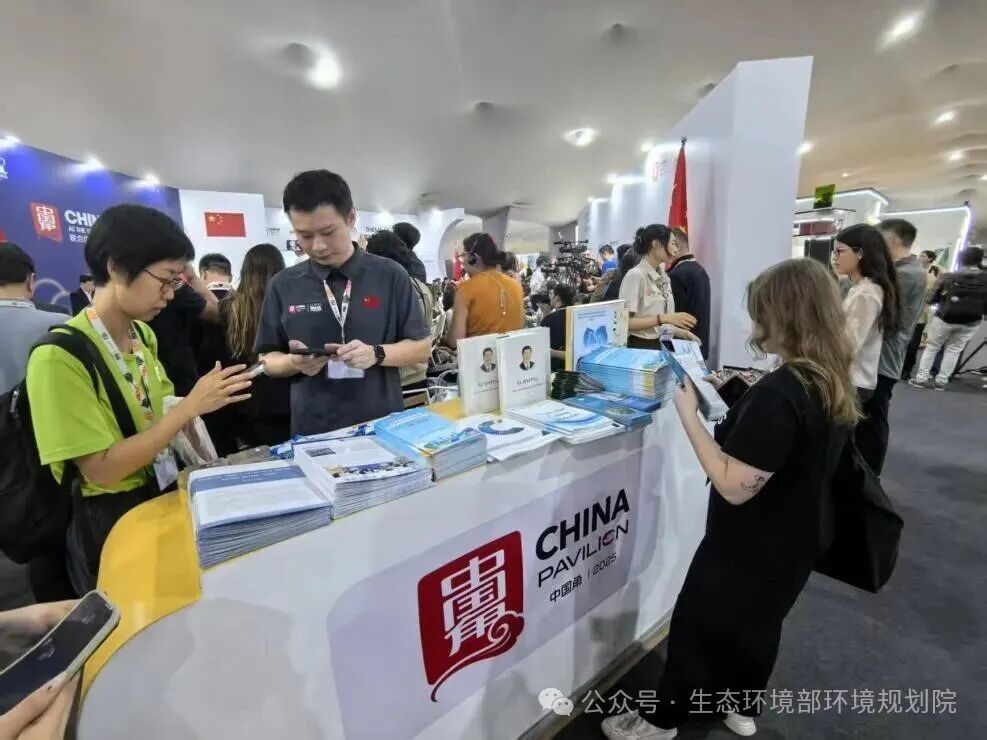

Date issued:2025-11-17
Spotlight on COP30 | A Series of Research Achievements by CAEP Are Unveiled at the UN Climate Change Conference COP30
On November 13th local time, during the 30th Conference of the Parties (COP30) to the United Nations Framework Convention on Climate Change held in Belém, Brazil, the Chinese Academy of Environmental Planning (CAEP) showcased and promoted three latest research achievements at the China Pavilion. The institute systematically introduced China’s technical schemes and policy recommendations regarding the transformation of traditional energy regions, industrial low-carbon technology pathways, and regional governance for carbon peaking and carbon neutrality, which garnered widespread attention from participants.

Against the backdrop of "just transition" emerging as one of the core topics of this conference, the report "Low-Carbon Transition of Traditional Energy Regions of China" by CAEP has attracted significant attention. Supported by the China Council for International Cooperation on Environment and Development (CCICED), the report is jointly led by CAEP, the Energy Research Institute of the National Development and Reform Commission, the Environmental Defense Fund (EDF) and the ClimateWorks Foundation. It brings together over 50 experts and scholars from more than 10 research institutions and international organizations for joint research and compilation. Focusing on the "Coal Triangle" consisting of four provinces and autonomous regions—Shanxi, Inner Mongolia, Shaanxi and Ningxia—the report adopts a combination of quantitative simulation, policy analysis and field research to systematically assess the green and low-carbon transition pathways and just transition strategies in the region in the process of achieving the carbon peaking and carbon neutrality goals. The report provides scientific support and policy reference for the sustainable transformation of traditional energy regions in China, and contributes Chinese wisdom and solutions to the global energy transition.
The report points out that in 2024, the region accounted for 79% of the national coal output and approximately 19.6% of the country's total carbon emissions. The study proposes that by promoting a strategy of parallel development—green energy substitution, traditional industrial upgrading, and emerging industry cultivation—the region is expected to reach peak carbon emissions during the "15th Five-Year Plan" period and achieve carbon neutrality around 2060. The report also emphasizes that fund guarantee and employment arrangement need to be coordinated during the transition process. It is estimated that the total demand for green transition funds in the region will be about 1.8 trillion yuan in the next five years, and the number of jobs in the green industry is expected to increase to 1.4 million.
Achievement 2: "Outlook on Industrial Low-carbon Technologies toward China's Carbon Neutrality Goal" Provides a Technology Roadmap for Industrial Decarbonization
Deep decarbonization of the industrial sector is a key area for China to achieve its "dual carbon" goals. Funded by the Energy Foundation, initiated by the Tsinghua University Institute for Carbon Neutrality, and led by CAEP, the report "Outlook on Low-Carbon Technologies for Industry Under China’s Carbon Neutrality Goal" was compiled in collaboration with key industry associations and research institutions in steel, building materials, non-ferrous metals, petrochemicals, coal chemical industry, digitalization and other fields. Focusing on the carbon neutrality needs of China’s industrial sector, the report systematically constructs a carbon neutrality technology map for major Chinese industrial sectors based on CAEP’s Comprehensive Assessment Model for China’s Medium and Long-Term Emissions (CAEP-CP 3.0). It also maps corresponding cost learning curves, outlines a phased timeline and roadmap for the development of industrial carbon neutrality technologies in China from 2025 to 2060, and provides decision-making support for strategic planning, major project deployment and policy formulation related to industrial low-carbon transition.
The report proposes that China’s industrial carbon emissions are expected to drop to 450 million tons by 2060, a decrease of approximately 95% compared with 2025. Technologies such as hydrogen replacement, electrification, feedstock substitution and CCUS will become the core pillars of industrial decarbonization, collectively contributing about 80% of emission reduction potential. The report also estimates that the cumulative investment demand for carbon neutrality technologies in China’s industrial sector will be approximately 42 trillion yuan between 2025 and 2060.

The Yangtze River Delta (YRD) region is one of the most economically dynamic regions in China. Its pathways to carbon peaking and carbon neutrality will provide important references for the country to achieve the "dual carbon" goals. Supported by the National Natural Science Foundation of China's special project "Research on Optimization of Regional Collaborative Pathways for Carbon Peaking and Carbon Neutrality", Academician Wang Jinnan led CAEP’s technical team to complete this report. Based on the CAEP-CP3.0 model, the study systematically assessed the low-carbon development pathways of the YRD region from 2020 to 2060.
Research results show that the YRD region is expected to reach its carbon emission peak in 2027 (approximately 2.43 billion tons) and achieve net-zero emissions around 2060. To support the high-quality realization of the region's carbon peaking and carbon neutrality goals, the study puts forward three suggestions: first, establish a three-level collaborative regional total control and market-oriented allocation system of "regional carbon budget - urban agglomeration carbon ticket - enterprise carbon quota", and set the total target of net-zero growth in carbon emissions during the 15th Five-Year Plan period and comprehensive reduction during the 16th Five-Year Plan period; second, innovate the "chain leader-driven industrial chain carbon governance system", with leading enterprises acting as "carbon chain leaders" to drive collaborative emission reduction across the entire industrial chain; third, build a global center for climate technology R&D and transformation, and an international carbon standard export center in the YRD region to accelerate the internationalization of China's carbon standards.
During COP30, the promotion of three research achievements of CAEP demonstrated the institute's systematic policy research and technical reserves in addressing climate change. These achievements provide actionable and replicable "China Solutions" for global climate governance. Moving forward, CAEP will continue to deepen relevant research, actively participate in international exchanges and cooperation, and contribute Chinese wisdom and strength to global climate change response efforts.
 Comments
Comments




 Home
Home

 京公网安备 11010702002483
京公网安备 11010702002483